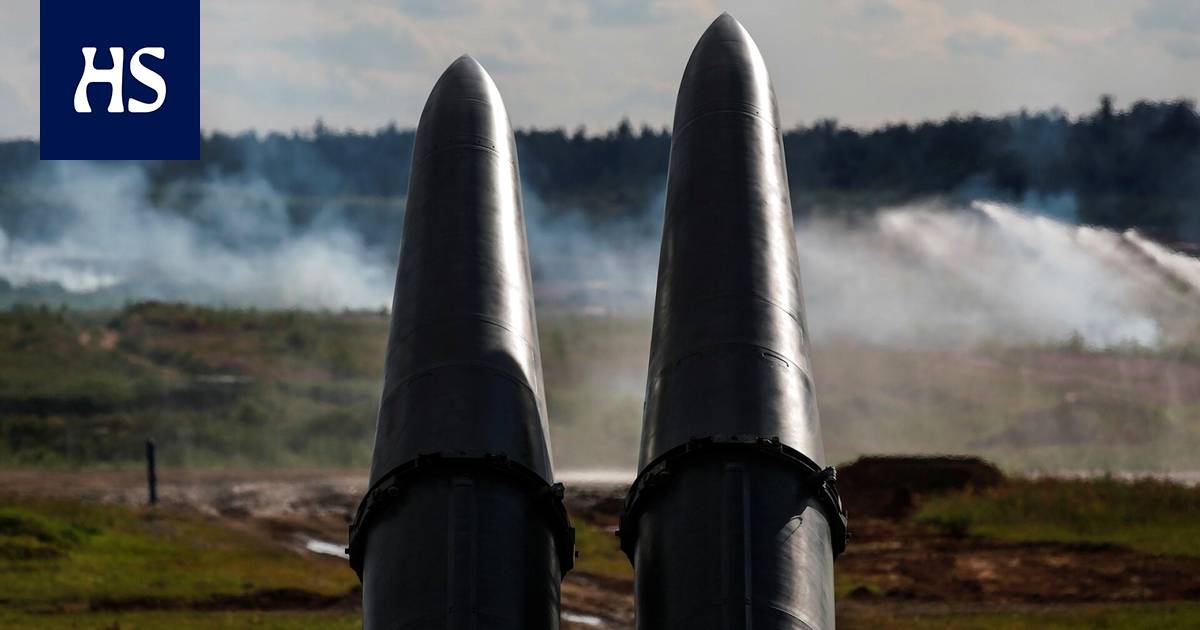26.3. 17:36 | Updated 26.3. 17:54
Speech Around Ukraine, the war has become increasingly intertwined with weapons of mass destruction and whether Russia could use them. Prime minister Sanna Marin (sd) said Thursdaythat everything can now be expected from Russia.
“Russia has shown through its actions that it is capable of anything. It does not follow any of the international rules of the game to which it has previously committed itself, ”Marin said.
So what would be Russia’s threshold for using weapons of mass destruction? Could the president Vladimir Putin press the trigger button on a nuclear weapon or harness an arsenal of chemical or biological weapons? HS interviewed experts on the subject.
Yet in January, Russia was involved in a joint statement, according to which a nuclear war cannot and must never be won. In February, Putin ordered Russia’s nuclear forces into a “high state of readiness,” the practical significance of which has remained obscure.
Katariina Simonen
Doctor of Laws, Docent Katariina Simonen The National Defense College estimates that this is a deterrent.
“If we look at what nuclear weapons Russia has had in operational readiness, that is, they have been deployed before that.”
Stockholm International Peace Research Institute Sipri evaluatesthat Russia had a total of 6,255 nuclear warheads last year. Of these, 1,625 were ready for launch.
Nuclear weapons There are two types: strategic and tactical. Strategic nuclear weapons include, for example, nuclear missiles and bombs. Tactical nuclear weapons are smaller weapons for combat use. Last year, Russia had roughly about 1,900 tactical nuclear weapons.
The Nagasaki nuclear bomb had an explosive power of 21 kilotonnes, but modern tactical nuclear weapons can have an explosive power of the order of a hundred kilotonnes or more.
For example, an explosion of 200 kt at Aviano’s base in Italy would be enough to pollute the whole of Western Europe, Simonen illustrates.
“
“The supply chain is already underway and contracts have crumbled.”
According to him, the use of tactical nuclear weapons is not regulated by any international agreement because the attention of the United States and Russia has been on the reduction of strategic nuclear weapons.
Simonen regrets that the nuclear weapons treaties have crumbled one after another in recent years. The INF deal, which removed medium-range missiles from Europe, collapsed when the president Donald Trump pulled the United States out of the agreement in 2019. Russia followed suit.
There are a lot of bad options left.
“The equipment cycle is already underway and contracts have crumbled. This has been going on for a long time, and the nuclear powers have massive modernization programs underway. The war in Ukraine has not triggered this development. ”
Unexploded ordnance short-range hypersonic ballistic missile in Kramatorsk. According to Ukrainian authorities, the missile was launched from the Iskander system.
Simonen still sees no indication that Russia is now more prepared to use a nuclear weapon. There is no “existential threat” in sight, and Ukraine is not like that, Simonen emphasizes.
“Russia is apparently annoyed by NATO’s missile defense systems deployed in Poland, which could in principle also be equipped with offensive weapons that would extend into Moscow.”
According to Simonen, the West and Russia must not be in a hurry now, because there is no room for mistakes.
“The history of nuclear weapons is full of cases where the launch of the other party has been misinterpreted as the launch of a nuclear weapon. That would be the place of the crisis. ”
The United States president Joe Biden has warned that Russia may be preparing for the use of chemical weapons in Ukraine. Chemical weapons include, but are not limited to, toxic chemicals intended to intentionally harm or kill a person.
Simonen has reservations about Biden’s remarks, as the United States has previously made false allegations about weapons of mass destruction in Iraq. Instead, he relies on data from international arms control communities.
Organization for the Prohibition of Chemical Weapons (OPCW) reported in 2017that Russia has demonstrably destroyed its entire stockpile of chemical weapons.
The following year, Russian spies poisoned him Sergei and Julia Skripalin with the novicok neurotoxin. The security service of the FSB also used the novice shock as an opposition politician Alexei Navalnyin poisoning in 2020.
“Russia still uses chemical weapons in covert operations. Still, poisoning is not the same as armed use. That would mean mass production, which should be driven up in warfare, ”Simonen says.
Russian opposition politician Alexei Navalnyi was poisoned with a novitoc in August 2020. He survived but was sent to Russia after returning to prison himself. In the picture, the nursing staff transferred Navalnyia on an stretcher to an ambulance in Omsk, Russia.
Chemical and the problem of the use of biological weapons is also difficult to control and unpredictable.
Director of the Research Department of the Center for Military Medicine, Professor Simo Nikkari emphasizes that biological weapons were banned internationally by the Geneva Convention in 1925. They should therefore not be present in contracting states such as Russia.
According to Nikkar, the weak point of the agreement is that there are no verifications in the control of the ban, as in the case of chemical weapons.
“As for Russia, all I can say is that they have a high level of biotechnology expertise,” he says.
“I do not know that Russia has not made a trusting statement about its own actions.”
However, there is evidence that the Soviet Union has violated common rules. In 1979, there was an anthrax epidemic in Sverdlovsk, or what is now Ekaterinburg, which resulted in several deaths.
“It turned out later that it was most obviously from a military research laboratory.”
Anthrax is, according to Nikkar, a classic pathogen used in biological weapons. In 2001, five people died in the United States who had opened letters containing anthrax spores.
Anthrax does not spread from person to person. Could such a biological – or chemical – weapon be used in a war in a targeted manner, for example to assassinate individuals? According to Nikkar, the opportunity exists.
Often, bioweapons are infectious diseases designed to harm or kill people, animals, or plants. They are plagues familiar from the history of mankind, with nothing new in themselves.
“The problem today is related to the rapid development of biotechnology and its regulation – and the fact that it cannot, in fact, be effectively regulated.”
Already destroyed smallpox virus strains are stored in only two laboratories in the world. One of them is located in Russia.
Nikkari states that deliberately releasing such a virus into the population would be completely irrational. According to him, this could only be done by terrorists, not by the state.
“Using an epidemic as a weapon of mass destruction would be as absurd as using a nuclear weapon.”
Russia itself has claimed that Ukraine is planning to use a biological weapon with US support. Nikkari says the allegations have no basis.
“Very far-fetched claims for which there is no basis.”
Nikkari led the health safety assessor in Ukraine international group in 2011. He notes that there are standard epidemiological research laboratories in Ukraine, funded by the United States and many other countries.
“
“If the laboratory is destroyed, there is undeniably a chance that the environment will be polluted.”
The World Health Organization has recommended that Ukraine eradicate pathogens stored in these laboratories for safety reasons. For years, the WHO has been instructing Ukraine in the event that pathogens escape “accidentally or intentionally”.
Nikkari says that such a scenario is mostly theoretical.
“Of course, if a situation arises in a crisis area, such as a power outage or the destruction of a laboratory, then there is no possibility that the environment will be polluted.”
Spring sowing is beginning in Ukraine. The success of the grain harvest is not only in Ukraine but also in many other countries important for security of supply. Could the crop be subjected to biological sabotage in a war situation?
“Yes, that is something the authorities should be prepared for,” says Nikkari on a general level.
Read more: The world’s largest grain producers are facing each other in the crisis in Ukraine – the war could also be seen on the shelf of the Finnish Food Trade
Read more: NATO promises additional aid to Ukraine in the fight against chemical weapons – Ukrainian president warns of widening war in video
Read more: President Biden: Europe must prepare for long sanctions – NATO responds if Russia uses chemical or biological weapons
Read more: Prime Minister Marin on Russia and chemical weapons: “We must be concerned”
#Russian #attack #Russia #weapon #mass #destruction #Ukraine #Epidemic #weapon #absurd #nuclear #weapon









